A Study of Competition in the Advertising Industry
VerifiedAdded on 2019/09/26
|8
|2295
|520
Essay
AI Summary
The global advertising economy is a competitive industry with various sized agencies, from small boutique operations to large multi- agency conglomerates. The latter compete on the basis of their creative teams, market knowledge, and global reach. Smaller agencies focus on delivering value-added services through in-depth knowledge of specific markets. New competition emerges as search companies like Google exploit their ability to interact with millions of potential consumers. The industry is experiencing a shift towards digital media, online advertising, and mobile devices.
Contribute Materials
Your contribution can guide someone’s learning journey. Share your
documents today.
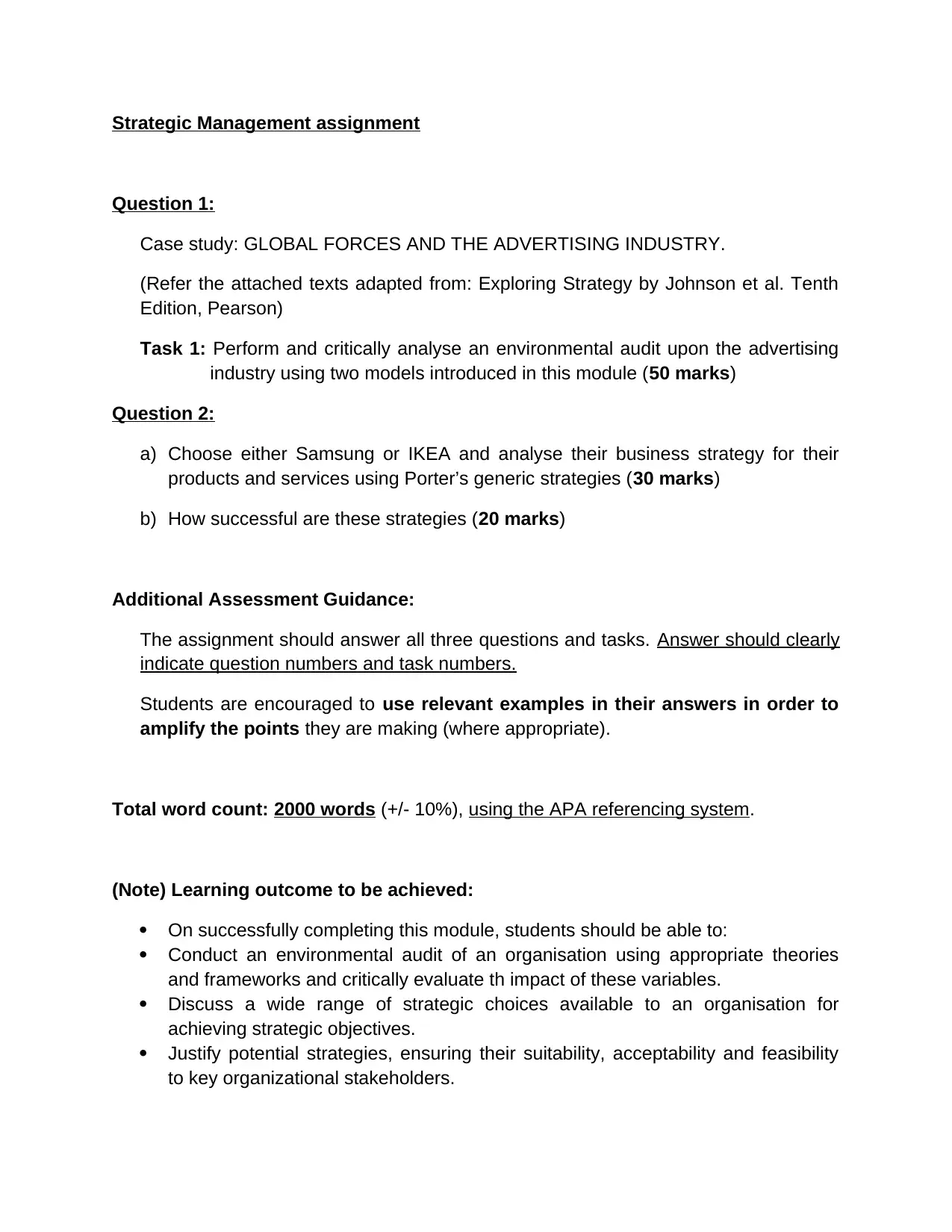
Strategic Management assignment
Question 1:
Case study: GLOBAL FORCES AND THE ADVERTISING INDUSTRY.
(Refer the attached texts adapted from: Exploring Strategy by Johnson et al. Tenth
Edition, Pearson)
Task 1: Perform and critically analyse an environmental audit upon the advertising
industry using two models introduced in this module (50 marks)
Question 2:
a) Choose either Samsung or IKEA and analyse their business strategy for their
products and services using Porter’s generic strategies (30 marks)
b) How successful are these strategies (20 marks)
Additional Assessment Guidance:
The assignment should answer all three questions and tasks. Answer should clearly
indicate question numbers and task numbers.
Students are encouraged to use relevant examples in their answers in order to
amplify the points they are making (where appropriate).
Total word count: 2000 words (+/- 10%), using the APA referencing system.
(Note) Learning outcome to be achieved:
On successfully completing this module, students should be able to:
Conduct an environmental audit of an organisation using appropriate theories
and frameworks and critically evaluate th impact of these variables.
Discuss a wide range of strategic choices available to an organisation for
achieving strategic objectives.
Justify potential strategies, ensuring their suitability, acceptability and feasibility
to key organizational stakeholders.
Question 1:
Case study: GLOBAL FORCES AND THE ADVERTISING INDUSTRY.
(Refer the attached texts adapted from: Exploring Strategy by Johnson et al. Tenth
Edition, Pearson)
Task 1: Perform and critically analyse an environmental audit upon the advertising
industry using two models introduced in this module (50 marks)
Question 2:
a) Choose either Samsung or IKEA and analyse their business strategy for their
products and services using Porter’s generic strategies (30 marks)
b) How successful are these strategies (20 marks)
Additional Assessment Guidance:
The assignment should answer all three questions and tasks. Answer should clearly
indicate question numbers and task numbers.
Students are encouraged to use relevant examples in their answers in order to
amplify the points they are making (where appropriate).
Total word count: 2000 words (+/- 10%), using the APA referencing system.
(Note) Learning outcome to be achieved:
On successfully completing this module, students should be able to:
Conduct an environmental audit of an organisation using appropriate theories
and frameworks and critically evaluate th impact of these variables.
Discuss a wide range of strategic choices available to an organisation for
achieving strategic objectives.
Justify potential strategies, ensuring their suitability, acceptability and feasibility
to key organizational stakeholders.
Secure Best Marks with AI Grader
Need help grading? Try our AI Grader for instant feedback on your assignments.
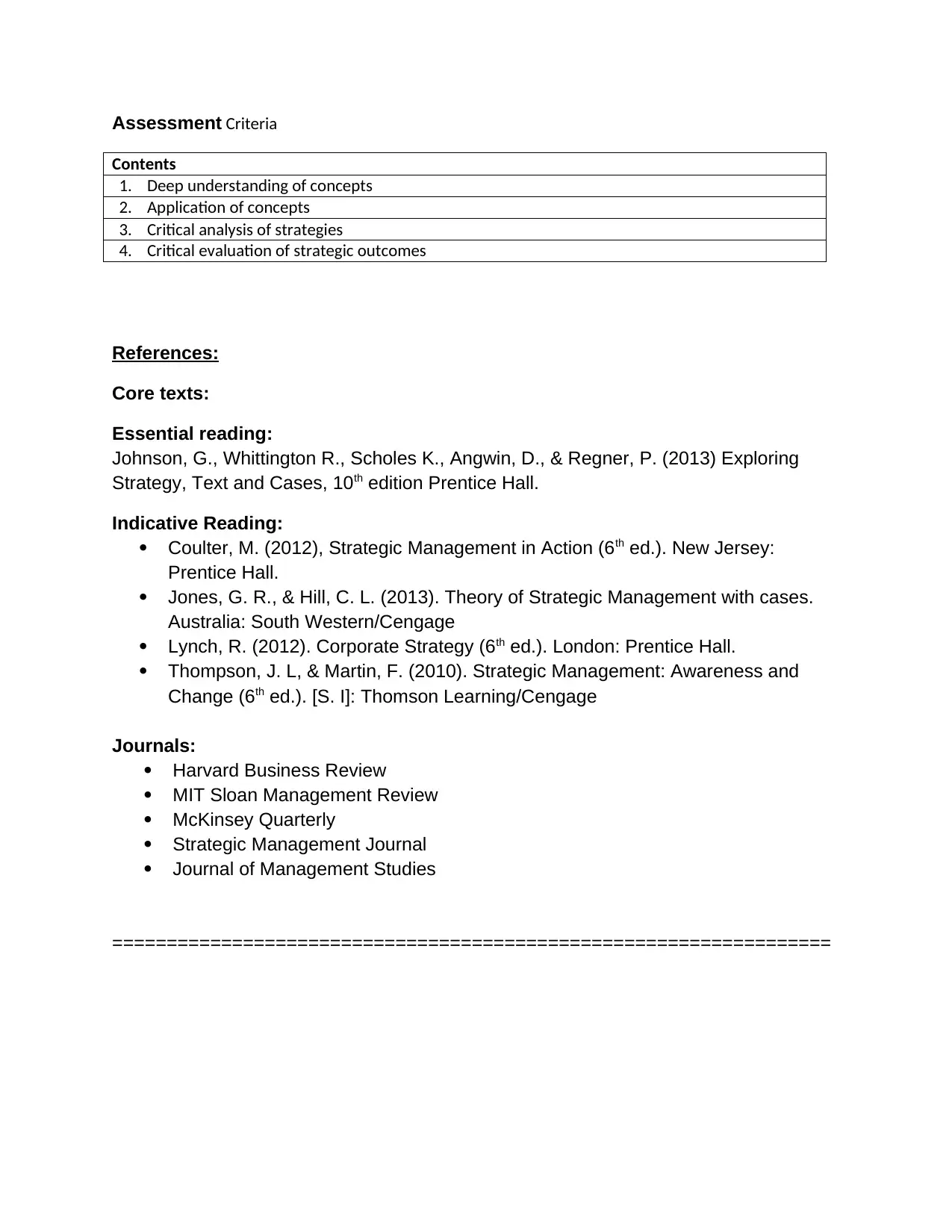
Assessment Criteria
Contents
1. Deep understanding of concepts
2. Application of concepts
3. Critical analysis of strategies
4. Critical evaluation of strategic outcomes
References:
Core texts:
Essential reading:
Johnson, G., Whittington R., Scholes K., Angwin, D., & Regner, P. (2013) Exploring
Strategy, Text and Cases, 10th edition Prentice Hall.
Indicative Reading:
Coulter, M. (2012), Strategic Management in Action (6th ed.). New Jersey:
Prentice Hall.
Jones, G. R., & Hill, C. L. (2013). Theory of Strategic Management with cases.
Australia: South Western/Cengage
Lynch, R. (2012). Corporate Strategy (6th ed.). London: Prentice Hall.
Thompson, J. L, & Martin, F. (2010). Strategic Management: Awareness and
Change (6th ed.). [S. I]: Thomson Learning/Cengage
Journals:
Harvard Business Review
MIT Sloan Management Review
McKinsey Quarterly
Strategic Management Journal
Journal of Management Studies
==================================================================
Contents
1. Deep understanding of concepts
2. Application of concepts
3. Critical analysis of strategies
4. Critical evaluation of strategic outcomes
References:
Core texts:
Essential reading:
Johnson, G., Whittington R., Scholes K., Angwin, D., & Regner, P. (2013) Exploring
Strategy, Text and Cases, 10th edition Prentice Hall.
Indicative Reading:
Coulter, M. (2012), Strategic Management in Action (6th ed.). New Jersey:
Prentice Hall.
Jones, G. R., & Hill, C. L. (2013). Theory of Strategic Management with cases.
Australia: South Western/Cengage
Lynch, R. (2012). Corporate Strategy (6th ed.). London: Prentice Hall.
Thompson, J. L, & Martin, F. (2010). Strategic Management: Awareness and
Change (6th ed.). [S. I]: Thomson Learning/Cengage
Journals:
Harvard Business Review
MIT Sloan Management Review
McKinsey Quarterly
Strategic Management Journal
Journal of Management Studies
==================================================================
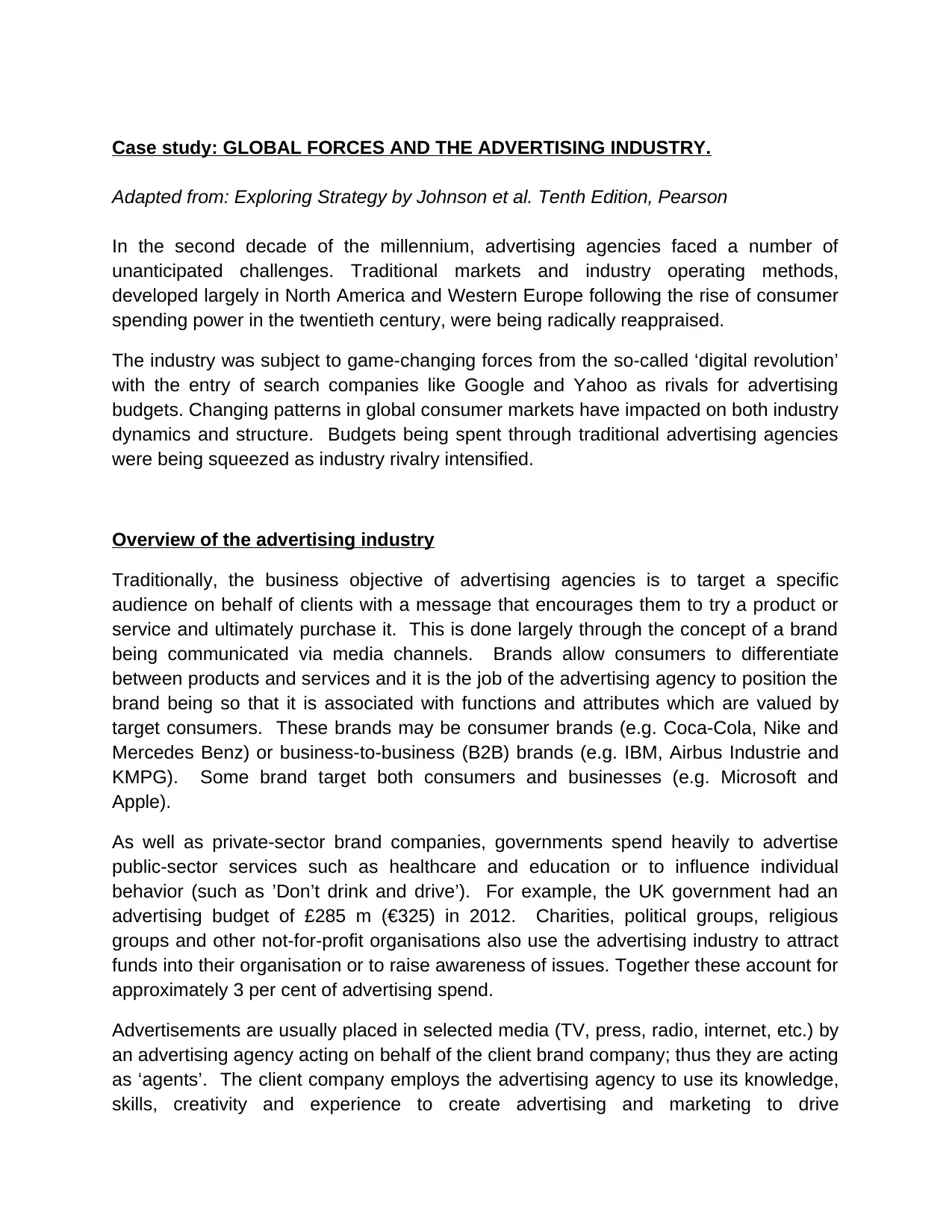
Case study: GLOBAL FORCES AND THE ADVERTISING INDUSTRY.
Adapted from: Exploring Strategy by Johnson et al. Tenth Edition, Pearson
In the second decade of the millennium, advertising agencies faced a number of
unanticipated challenges. Traditional markets and industry operating methods,
developed largely in North America and Western Europe following the rise of consumer
spending power in the twentieth century, were being radically reappraised.
The industry was subject to game-changing forces from the so-called ‘digital revolution’
with the entry of search companies like Google and Yahoo as rivals for advertising
budgets. Changing patterns in global consumer markets have impacted on both industry
dynamics and structure. Budgets being spent through traditional advertising agencies
were being squeezed as industry rivalry intensified.
Overview of the advertising industry
Traditionally, the business objective of advertising agencies is to target a specific
audience on behalf of clients with a message that encourages them to try a product or
service and ultimately purchase it. This is done largely through the concept of a brand
being communicated via media channels. Brands allow consumers to differentiate
between products and services and it is the job of the advertising agency to position the
brand being so that it is associated with functions and attributes which are valued by
target consumers. These brands may be consumer brands (e.g. Coca-Cola, Nike and
Mercedes Benz) or business-to-business (B2B) brands (e.g. IBM, Airbus Industrie and
KMPG). Some brand target both consumers and businesses (e.g. Microsoft and
Apple).
As well as private-sector brand companies, governments spend heavily to advertise
public-sector services such as healthcare and education or to influence individual
behavior (such as ’Don’t drink and drive’). For example, the UK government had an
advertising budget of £285 m (€325) in 2012. Charities, political groups, religious
groups and other not-for-profit organisations also use the advertising industry to attract
funds into their organisation or to raise awareness of issues. Together these account for
approximately 3 per cent of advertising spend.
Advertisements are usually placed in selected media (TV, press, radio, internet, etc.) by
an advertising agency acting on behalf of the client brand company; thus they are acting
as ‘agents’. The client company employs the advertising agency to use its knowledge,
skills, creativity and experience to create advertising and marketing to drive
Adapted from: Exploring Strategy by Johnson et al. Tenth Edition, Pearson
In the second decade of the millennium, advertising agencies faced a number of
unanticipated challenges. Traditional markets and industry operating methods,
developed largely in North America and Western Europe following the rise of consumer
spending power in the twentieth century, were being radically reappraised.
The industry was subject to game-changing forces from the so-called ‘digital revolution’
with the entry of search companies like Google and Yahoo as rivals for advertising
budgets. Changing patterns in global consumer markets have impacted on both industry
dynamics and structure. Budgets being spent through traditional advertising agencies
were being squeezed as industry rivalry intensified.
Overview of the advertising industry
Traditionally, the business objective of advertising agencies is to target a specific
audience on behalf of clients with a message that encourages them to try a product or
service and ultimately purchase it. This is done largely through the concept of a brand
being communicated via media channels. Brands allow consumers to differentiate
between products and services and it is the job of the advertising agency to position the
brand being so that it is associated with functions and attributes which are valued by
target consumers. These brands may be consumer brands (e.g. Coca-Cola, Nike and
Mercedes Benz) or business-to-business (B2B) brands (e.g. IBM, Airbus Industrie and
KMPG). Some brand target both consumers and businesses (e.g. Microsoft and
Apple).
As well as private-sector brand companies, governments spend heavily to advertise
public-sector services such as healthcare and education or to influence individual
behavior (such as ’Don’t drink and drive’). For example, the UK government had an
advertising budget of £285 m (€325) in 2012. Charities, political groups, religious
groups and other not-for-profit organisations also use the advertising industry to attract
funds into their organisation or to raise awareness of issues. Together these account for
approximately 3 per cent of advertising spend.
Advertisements are usually placed in selected media (TV, press, radio, internet, etc.) by
an advertising agency acting on behalf of the client brand company; thus they are acting
as ‘agents’. The client company employs the advertising agency to use its knowledge,
skills, creativity and experience to create advertising and marketing to drive
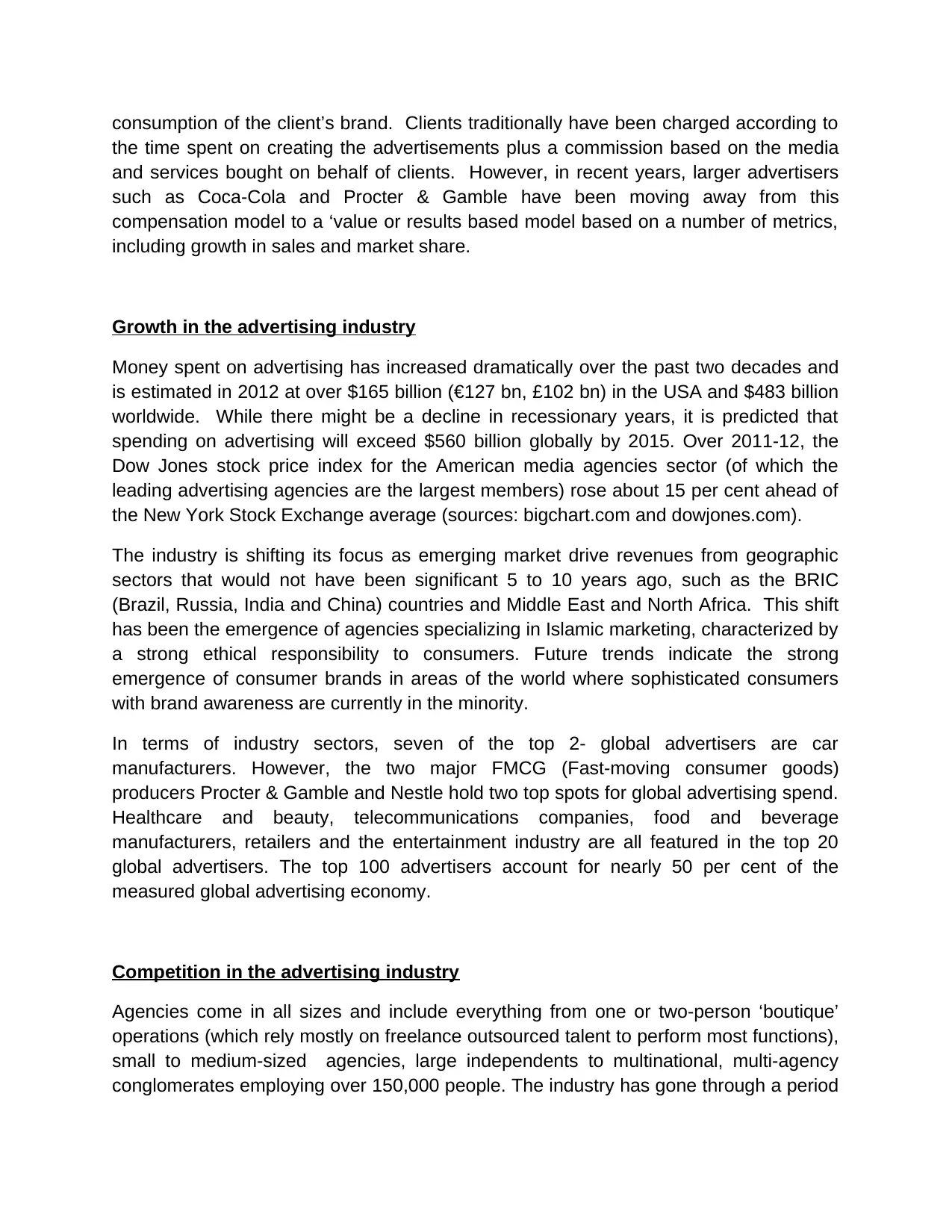
consumption of the client’s brand. Clients traditionally have been charged according to
the time spent on creating the advertisements plus a commission based on the media
and services bought on behalf of clients. However, in recent years, larger advertisers
such as Coca-Cola and Procter & Gamble have been moving away from this
compensation model to a ‘value or results based model based on a number of metrics,
including growth in sales and market share.
Growth in the advertising industry
Money spent on advertising has increased dramatically over the past two decades and
is estimated in 2012 at over $165 billion (€127 bn, £102 bn) in the USA and $483 billion
worldwide. While there might be a decline in recessionary years, it is predicted that
spending on advertising will exceed $560 billion globally by 2015. Over 2011-12, the
Dow Jones stock price index for the American media agencies sector (of which the
leading advertising agencies are the largest members) rose about 15 per cent ahead of
the New York Stock Exchange average (sources: bigchart.com and dowjones.com).
The industry is shifting its focus as emerging market drive revenues from geographic
sectors that would not have been significant 5 to 10 years ago, such as the BRIC
(Brazil, Russia, India and China) countries and Middle East and North Africa. This shift
has been the emergence of agencies specializing in Islamic marketing, characterized by
a strong ethical responsibility to consumers. Future trends indicate the strong
emergence of consumer brands in areas of the world where sophisticated consumers
with brand awareness are currently in the minority.
In terms of industry sectors, seven of the top 2- global advertisers are car
manufacturers. However, the two major FMCG (Fast-moving consumer goods)
producers Procter & Gamble and Nestle hold two top spots for global advertising spend.
Healthcare and beauty, telecommunications companies, food and beverage
manufacturers, retailers and the entertainment industry are all featured in the top 20
global advertisers. The top 100 advertisers account for nearly 50 per cent of the
measured global advertising economy.
Competition in the advertising industry
Agencies come in all sizes and include everything from one or two-person ‘boutique’
operations (which rely mostly on freelance outsourced talent to perform most functions),
small to medium-sized agencies, large independents to multinational, multi-agency
conglomerates employing over 150,000 people. The industry has gone through a period
the time spent on creating the advertisements plus a commission based on the media
and services bought on behalf of clients. However, in recent years, larger advertisers
such as Coca-Cola and Procter & Gamble have been moving away from this
compensation model to a ‘value or results based model based on a number of metrics,
including growth in sales and market share.
Growth in the advertising industry
Money spent on advertising has increased dramatically over the past two decades and
is estimated in 2012 at over $165 billion (€127 bn, £102 bn) in the USA and $483 billion
worldwide. While there might be a decline in recessionary years, it is predicted that
spending on advertising will exceed $560 billion globally by 2015. Over 2011-12, the
Dow Jones stock price index for the American media agencies sector (of which the
leading advertising agencies are the largest members) rose about 15 per cent ahead of
the New York Stock Exchange average (sources: bigchart.com and dowjones.com).
The industry is shifting its focus as emerging market drive revenues from geographic
sectors that would not have been significant 5 to 10 years ago, such as the BRIC
(Brazil, Russia, India and China) countries and Middle East and North Africa. This shift
has been the emergence of agencies specializing in Islamic marketing, characterized by
a strong ethical responsibility to consumers. Future trends indicate the strong
emergence of consumer brands in areas of the world where sophisticated consumers
with brand awareness are currently in the minority.
In terms of industry sectors, seven of the top 2- global advertisers are car
manufacturers. However, the two major FMCG (Fast-moving consumer goods)
producers Procter & Gamble and Nestle hold two top spots for global advertising spend.
Healthcare and beauty, telecommunications companies, food and beverage
manufacturers, retailers and the entertainment industry are all featured in the top 20
global advertisers. The top 100 advertisers account for nearly 50 per cent of the
measured global advertising economy.
Competition in the advertising industry
Agencies come in all sizes and include everything from one or two-person ‘boutique’
operations (which rely mostly on freelance outsourced talent to perform most functions),
small to medium-sized agencies, large independents to multinational, multi-agency
conglomerates employing over 150,000 people. The industry has gone through a period
Secure Best Marks with AI Grader
Need help grading? Try our AI Grader for instant feedback on your assignments.
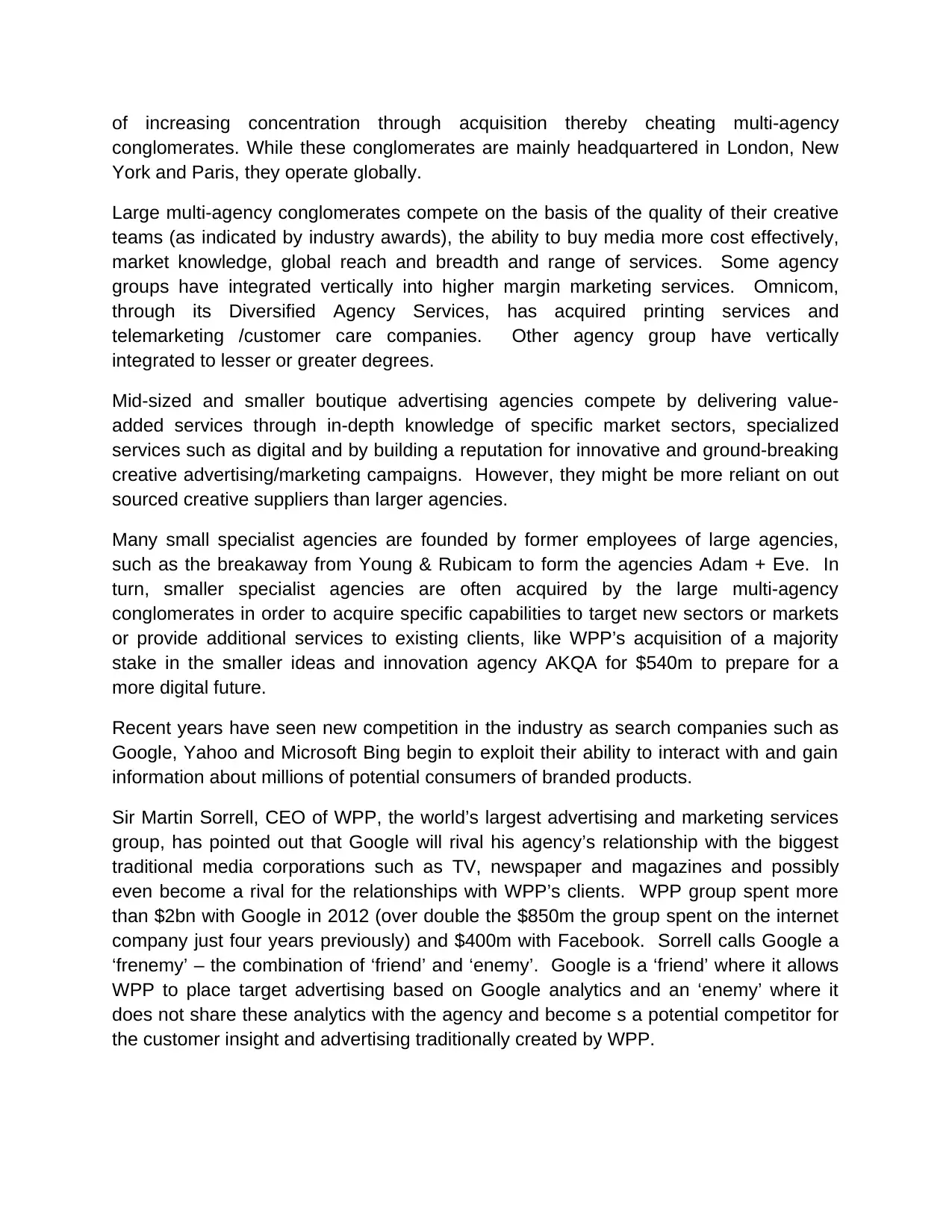
of increasing concentration through acquisition thereby cheating multi-agency
conglomerates. While these conglomerates are mainly headquartered in London, New
York and Paris, they operate globally.
Large multi-agency conglomerates compete on the basis of the quality of their creative
teams (as indicated by industry awards), the ability to buy media more cost effectively,
market knowledge, global reach and breadth and range of services. Some agency
groups have integrated vertically into higher margin marketing services. Omnicom,
through its Diversified Agency Services, has acquired printing services and
telemarketing /customer care companies. Other agency group have vertically
integrated to lesser or greater degrees.
Mid-sized and smaller boutique advertising agencies compete by delivering value-
added services through in-depth knowledge of specific market sectors, specialized
services such as digital and by building a reputation for innovative and ground-breaking
creative advertising/marketing campaigns. However, they might be more reliant on out
sourced creative suppliers than larger agencies.
Many small specialist agencies are founded by former employees of large agencies,
such as the breakaway from Young & Rubicam to form the agencies Adam + Eve. In
turn, smaller specialist agencies are often acquired by the large multi-agency
conglomerates in order to acquire specific capabilities to target new sectors or markets
or provide additional services to existing clients, like WPP’s acquisition of a majority
stake in the smaller ideas and innovation agency AKQA for $540m to prepare for a
more digital future.
Recent years have seen new competition in the industry as search companies such as
Google, Yahoo and Microsoft Bing begin to exploit their ability to interact with and gain
information about millions of potential consumers of branded products.
Sir Martin Sorrell, CEO of WPP, the world’s largest advertising and marketing services
group, has pointed out that Google will rival his agency’s relationship with the biggest
traditional media corporations such as TV, newspaper and magazines and possibly
even become a rival for the relationships with WPP’s clients. WPP group spent more
than $2bn with Google in 2012 (over double the $850m the group spent on the internet
company just four years previously) and $400m with Facebook. Sorrell calls Google a
‘frenemy’ – the combination of ‘friend’ and ‘enemy’. Google is a ‘friend’ where it allows
WPP to place target advertising based on Google analytics and an ‘enemy’ where it
does not share these analytics with the agency and become s a potential competitor for
the customer insight and advertising traditionally created by WPP.
conglomerates. While these conglomerates are mainly headquartered in London, New
York and Paris, they operate globally.
Large multi-agency conglomerates compete on the basis of the quality of their creative
teams (as indicated by industry awards), the ability to buy media more cost effectively,
market knowledge, global reach and breadth and range of services. Some agency
groups have integrated vertically into higher margin marketing services. Omnicom,
through its Diversified Agency Services, has acquired printing services and
telemarketing /customer care companies. Other agency group have vertically
integrated to lesser or greater degrees.
Mid-sized and smaller boutique advertising agencies compete by delivering value-
added services through in-depth knowledge of specific market sectors, specialized
services such as digital and by building a reputation for innovative and ground-breaking
creative advertising/marketing campaigns. However, they might be more reliant on out
sourced creative suppliers than larger agencies.
Many small specialist agencies are founded by former employees of large agencies,
such as the breakaway from Young & Rubicam to form the agencies Adam + Eve. In
turn, smaller specialist agencies are often acquired by the large multi-agency
conglomerates in order to acquire specific capabilities to target new sectors or markets
or provide additional services to existing clients, like WPP’s acquisition of a majority
stake in the smaller ideas and innovation agency AKQA for $540m to prepare for a
more digital future.
Recent years have seen new competition in the industry as search companies such as
Google, Yahoo and Microsoft Bing begin to exploit their ability to interact with and gain
information about millions of potential consumers of branded products.
Sir Martin Sorrell, CEO of WPP, the world’s largest advertising and marketing services
group, has pointed out that Google will rival his agency’s relationship with the biggest
traditional media corporations such as TV, newspaper and magazines and possibly
even become a rival for the relationships with WPP’s clients. WPP group spent more
than $2bn with Google in 2012 (over double the $850m the group spent on the internet
company just four years previously) and $400m with Facebook. Sorrell calls Google a
‘frenemy’ – the combination of ‘friend’ and ‘enemy’. Google is a ‘friend’ where it allows
WPP to place target advertising based on Google analytics and an ‘enemy’ where it
does not share these analytics with the agency and become s a potential competitor for
the customer insight and advertising traditionally created by WPP.
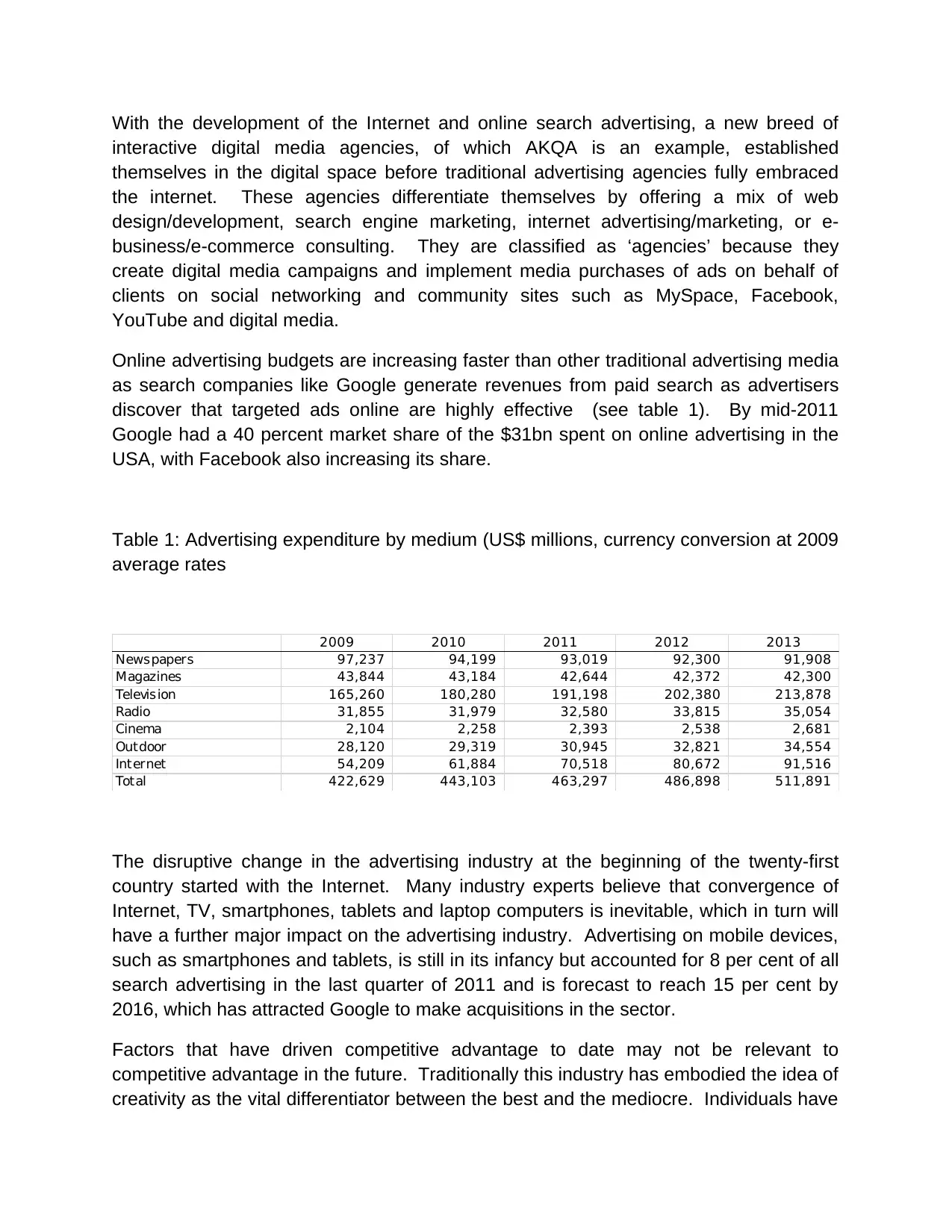
With the development of the Internet and online search advertising, a new breed of
interactive digital media agencies, of which AKQA is an example, established
themselves in the digital space before traditional advertising agencies fully embraced
the internet. These agencies differentiate themselves by offering a mix of web
design/development, search engine marketing, internet advertising/marketing, or e-
business/e-commerce consulting. They are classified as ‘agencies’ because they
create digital media campaigns and implement media purchases of ads on behalf of
clients on social networking and community sites such as MySpace, Facebook,
YouTube and digital media.
Online advertising budgets are increasing faster than other traditional advertising media
as search companies like Google generate revenues from paid search as advertisers
discover that targeted ads online are highly effective (see table 1). By mid-2011
Google had a 40 percent market share of the $31bn spent on online advertising in the
USA, with Facebook also increasing its share.
Table 1: Advertising expenditure by medium (US$ millions, currency conversion at 2009
average rates
2009 2010 2011 2012 2013
Newspapers 97,237 94,199 93,019 92,300 91,908
Magazines 43,844 43,184 42,644 42,372 42,300
Television 165,260 180,280 191,198 202,380 213,878
Radio 31,855 31,979 32,580 33,815 35,054
Cinema 2,104 2,258 2,393 2,538 2,681
Outdoor 28,120 29,319 30,945 32,821 34,554
Internet 54,209 61,884 70,518 80,672 91,516
Total 422,629 443,103 463,297 486,898 511,891
The disruptive change in the advertising industry at the beginning of the twenty-first
country started with the Internet. Many industry experts believe that convergence of
Internet, TV, smartphones, tablets and laptop computers is inevitable, which in turn will
have a further major impact on the advertising industry. Advertising on mobile devices,
such as smartphones and tablets, is still in its infancy but accounted for 8 per cent of all
search advertising in the last quarter of 2011 and is forecast to reach 15 per cent by
2016, which has attracted Google to make acquisitions in the sector.
Factors that have driven competitive advantage to date may not be relevant to
competitive advantage in the future. Traditionally this industry has embodied the idea of
creativity as the vital differentiator between the best and the mediocre. Individuals have
interactive digital media agencies, of which AKQA is an example, established
themselves in the digital space before traditional advertising agencies fully embraced
the internet. These agencies differentiate themselves by offering a mix of web
design/development, search engine marketing, internet advertising/marketing, or e-
business/e-commerce consulting. They are classified as ‘agencies’ because they
create digital media campaigns and implement media purchases of ads on behalf of
clients on social networking and community sites such as MySpace, Facebook,
YouTube and digital media.
Online advertising budgets are increasing faster than other traditional advertising media
as search companies like Google generate revenues from paid search as advertisers
discover that targeted ads online are highly effective (see table 1). By mid-2011
Google had a 40 percent market share of the $31bn spent on online advertising in the
USA, with Facebook also increasing its share.
Table 1: Advertising expenditure by medium (US$ millions, currency conversion at 2009
average rates
2009 2010 2011 2012 2013
Newspapers 97,237 94,199 93,019 92,300 91,908
Magazines 43,844 43,184 42,644 42,372 42,300
Television 165,260 180,280 191,198 202,380 213,878
Radio 31,855 31,979 32,580 33,815 35,054
Cinema 2,104 2,258 2,393 2,538 2,681
Outdoor 28,120 29,319 30,945 32,821 34,554
Internet 54,209 61,884 70,518 80,672 91,516
Total 422,629 443,103 463,297 486,898 511,891
The disruptive change in the advertising industry at the beginning of the twenty-first
country started with the Internet. Many industry experts believe that convergence of
Internet, TV, smartphones, tablets and laptop computers is inevitable, which in turn will
have a further major impact on the advertising industry. Advertising on mobile devices,
such as smartphones and tablets, is still in its infancy but accounted for 8 per cent of all
search advertising in the last quarter of 2011 and is forecast to reach 15 per cent by
2016, which has attracted Google to make acquisitions in the sector.
Factors that have driven competitive advantage to date may not be relevant to
competitive advantage in the future. Traditionally this industry has embodied the idea of
creativity as the vital differentiator between the best and the mediocre. Individuals have
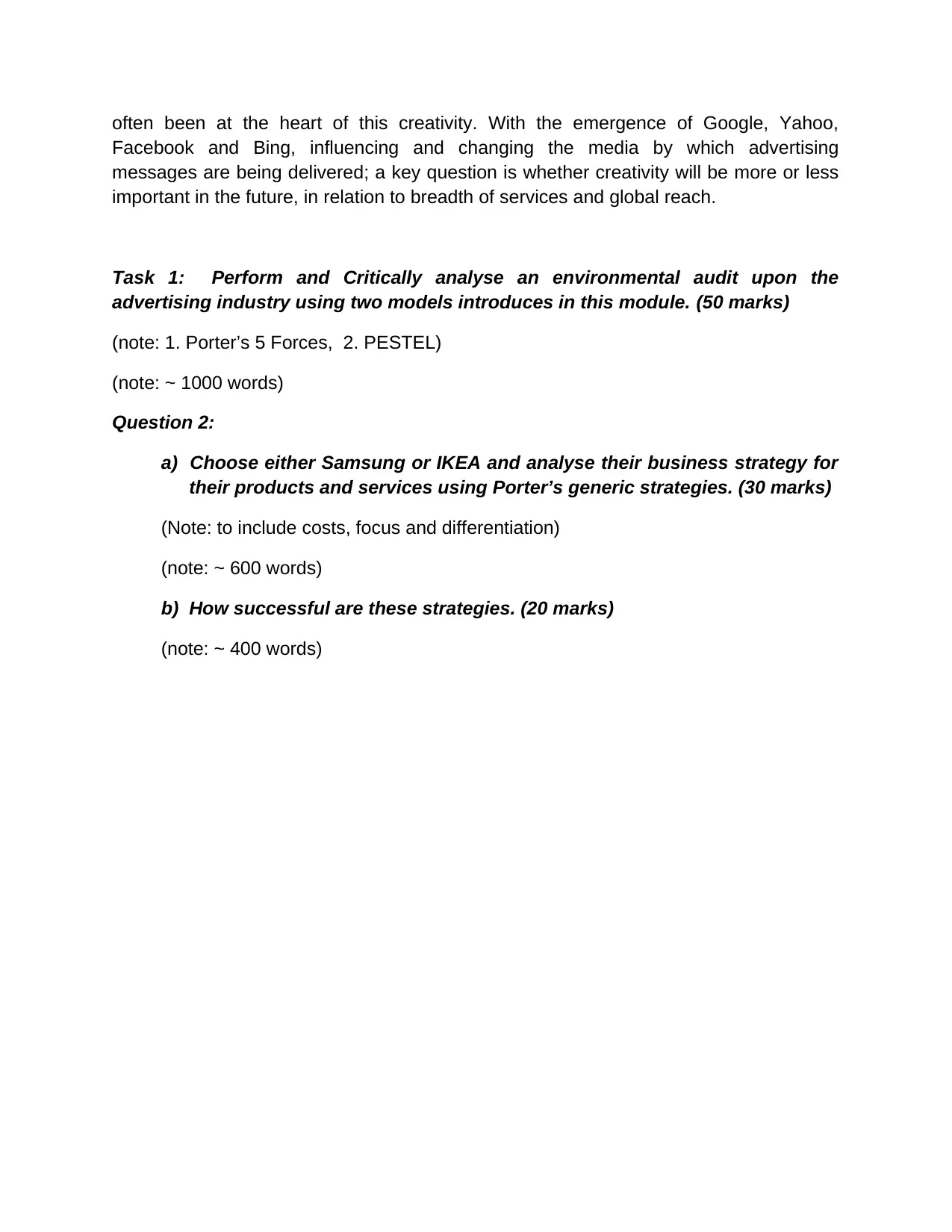
often been at the heart of this creativity. With the emergence of Google, Yahoo,
Facebook and Bing, influencing and changing the media by which advertising
messages are being delivered; a key question is whether creativity will be more or less
important in the future, in relation to breadth of services and global reach.
Task 1: Perform and Critically analyse an environmental audit upon the
advertising industry using two models introduces in this module. (50 marks)
(note: 1. Porter’s 5 Forces, 2. PESTEL)
(note: ~ 1000 words)
Question 2:
a) Choose either Samsung or IKEA and analyse their business strategy for
their products and services using Porter’s generic strategies. (30 marks)
(Note: to include costs, focus and differentiation)
(note: ~ 600 words)
b) How successful are these strategies. (20 marks)
(note: ~ 400 words)
Facebook and Bing, influencing and changing the media by which advertising
messages are being delivered; a key question is whether creativity will be more or less
important in the future, in relation to breadth of services and global reach.
Task 1: Perform and Critically analyse an environmental audit upon the
advertising industry using two models introduces in this module. (50 marks)
(note: 1. Porter’s 5 Forces, 2. PESTEL)
(note: ~ 1000 words)
Question 2:
a) Choose either Samsung or IKEA and analyse their business strategy for
their products and services using Porter’s generic strategies. (30 marks)
(Note: to include costs, focus and differentiation)
(note: ~ 600 words)
b) How successful are these strategies. (20 marks)
(note: ~ 400 words)
Paraphrase This Document
Need a fresh take? Get an instant paraphrase of this document with our AI Paraphraser

1 out of 8
Your All-in-One AI-Powered Toolkit for Academic Success.
+13062052269
info@desklib.com
Available 24*7 on WhatsApp / Email
![[object Object]](/_next/static/media/star-bottom.7253800d.svg)
Unlock your academic potential
© 2024 | Zucol Services PVT LTD | All rights reserved.
